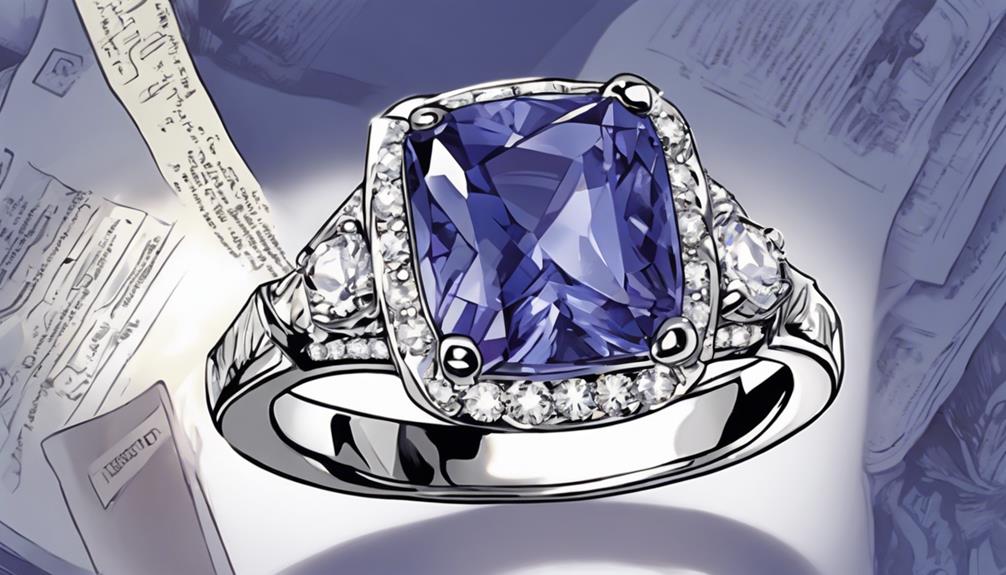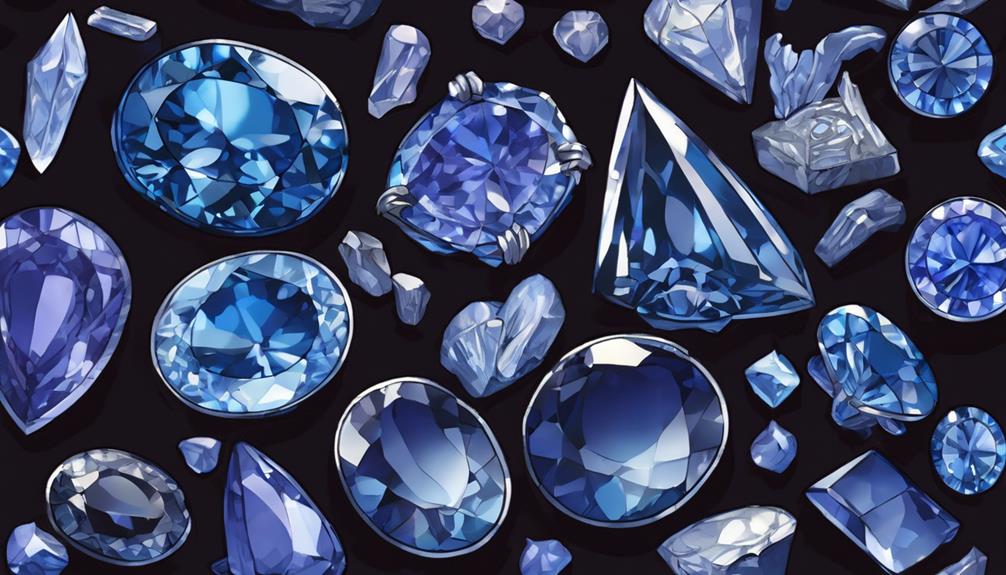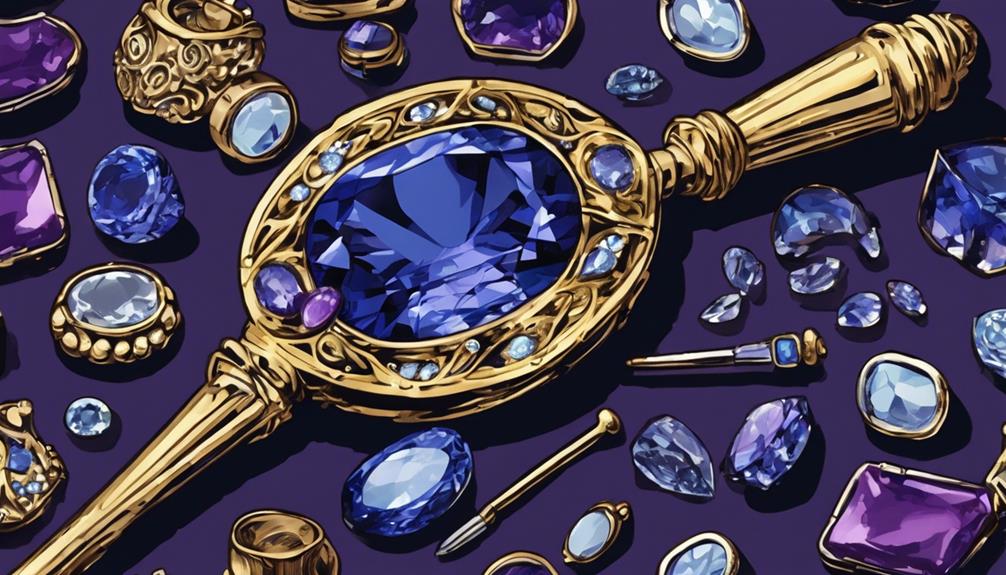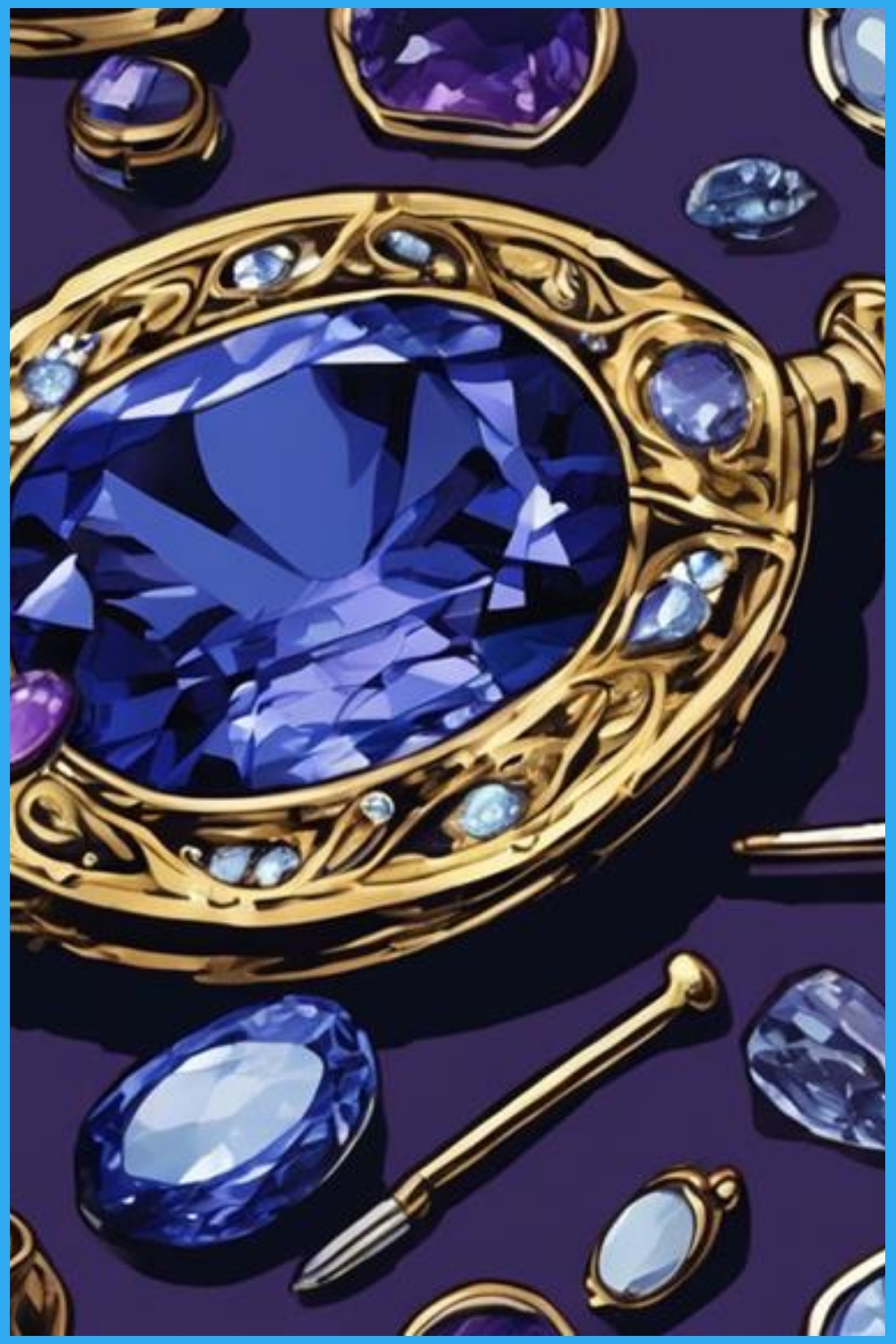Article Contents
- 1 A Guide to Purchasing Tanzanite: The Enchanting Blue Gemstone
- 2 Main Highlights
- 3 Understanding Tanzanite: A Jewel of Unique Origins
- 4 Understanding Tanzanite’s Colour Dynamics
- 5 Pleochroism in Tanzanite
- 6 Clarity and Quality
- 7 Choosing the Ideal Cut for Tanzanite
- 8 Carat and Size
- 9 Jewellery and Investment: A Closer Look at Tanzanite
- 10 Tanzanite Treatments
- 11 Tanzanite Simulants and Synthetics
- 12 Frequently Asked Questions
- 13 Can Tanzanite Be Paired with Diamond Engagement Rings for a Unique Wedding Set?
- 14 Conclusion
A Guide to Purchasing Tanzanite: The Enchanting Blue Gemstone
Tanzanite, a gemstone of exceptional rarity, is exclusively found within a limited 20 square mile region of Tanzania. Its captivating blue-to-violet hues, achieved through careful heat treatment, evoke a sense of profound beauty and mystery.
When selecting tanzanite, consider its pleochroic nature. This unique property reveals different colours depending on the viewing angle, adding a fascinating depth to its allure.
High clarity further enhances its brilliance, while the choice of cut, often oval or cushion, can showcase its distinct characteristics. Larger stones, especially those over five carats, exhibit the richest colours.
For those intrigued by the qualities of this remarkable gemstone, the journey of discovery continues with every piece you encounter.
Main Highlights
When purchasing tanzanite, consider the following tips to ensure you get a high-quality gem:
- Optimal Colour Tone: Choose tanzanite stones with a colour tone between 75-85% for the most vivid blue appearance. This range offers the richest and most desirable hues.
- Heat Treatment: Make sure the stone has undergone controlled heat treatment. This process enhances the blue and violet hues, making the gem more visually appealing.
- Clarity: Check the gem’s clarity. Stones with high clarity and no visible inclusions are more valuable and have greater brilliance.
- Reputable Dealers: Buy from reputable dealers to avoid smuggled or illicit stones. This ensures the authenticity of the gem and supports ethical practices.
- Stone Size: Consider larger stones, particularly those over 5 carats. Larger tanzanites often exhibit more intense colour and are generally more valuable.
By keeping these factors in mind, you’ll be well-equipped to choose a stunning tanzanite gem that meets your expectations.
Understanding Tanzanite: A Jewel of Unique Origins
To truly appreciate tanzanite, one must first recognise its distinctive colour properties and the specific geological conditions that contribute to its formation. Discovered in 1967 near the majestic Mt. Kilimanjaro, tanzanite’s origin story is as captivating as its colours.
This gemstone, a rare variety of zoisite, is found exclusively in Tanzania. The mining area is limited to just 20 square miles, making tanzanite one of the rarest gemstones in the world, which significantly enhances its value.
Tanzanite’s rarity is further highlighted by its unique colour transformation, achieved through heat treatment. The journey from a rough stone to a polished gem requires meticulous care during both extraction and processing. The striking blue-to-violet hues mesmerise collectors and gem enthusiasts, adding a layer of allure to its value.
To maintain its beauty, proper care and cleaning of tanzanite are vital. Given its relative softness and brittleness, it should be handled with care. Clean tanzanite using mild soap and warm water, avoiding harsh chemicals and ultrasonic cleaners that could damage the stone. This ensures that tanzanite remains as stunning as the day it was discovered.
Understanding Tanzanite’s Colour Dynamics
To truly appreciate tanzanite’s beauty, one must delve into its colour properties, particularly the vivid hues achieved through both natural and heat treatment processes. Tanzanite’s colour spectrum, ranging from deep blues to striking purples, significantly influences its market trends and desirability. While some naturally occurring tanzanite displays these colours due to solar heating, most stones undergo controlled heat treatment to enhance their hues.
It is important to recognise the distinction between natural and treated colour. Naturally heated tanzanite stones are rare and often more valued by purists, whereas heat-treated stones are more common but display colours that are just as captivating. The primary hues of tanzanite—blue and violet—carry significant symbolism and cultural importance, often associated with tranquility, royalty, and transformation.
The ideal colour tone for tanzanite is between 75-85%, which ensures an intense and vivid appearance. Lighter tones may seem lacklustre, while darker hues can appear overly sombre. Additionally, rare specimens of zoisite in green, yellow, or pink hues, though not classified as tanzanite, are highly prized by collectors.
Pleochroism in Tanzanite
Pleochroism in tanzanite, where the gem shows different colours when viewed from various angles, significantly contributes to its charm and worth. This intriguing characteristic arises from tanzanite’s unique crystalline structure, which allows it to display a range of colours based on the viewing angle and crystal orientation. The primary colours seen in pleochroic tanzanite typically range from deep blue to rich purple, and on occasion, you might also observe green-yellow to brown hues.
As light travels through the gem, different wavelengths are absorbed and refracted in multiple directions. This interaction between light and the crystal structure creates a dynamic visual effect that can change dramatically with even a slight shift in perspective. These shifting colours make tanzanite a captivating gemstone, offering a visual experience that is both intriguing and mesmerising. Citrine benefits from similar properties, as it is also known for its ability to refract light and create vibrant, shifting colours. However, unlike tanzanite, citrine is more commonly found in warm hues of yellow, orange, and brown, making it an ideal choice for those seeking a sunny and cheerful gemstone. In addition to its visual appeal, citrine benefits also include metaphysical properties such as promoting positivity, abundance, and clarity in the wearer’s life. The benefits of citrine extend beyond its visual appeal. This gemstone is believed to carry energizing and revitalizing properties, making it a popular choice for those seeking an uplift in mood and spirit. Furthermore, the benefits of citrine extend to its reputation as a stone of abundance and prosperity, with some believing that it can attract wealth and success. Overall, the benefits of citrine make it a desirable gemstone not only for its aesthetic qualities but also for its potential positive impact on the wearer’s life.
Gem cutters, known as lapidaries, must carefully consider these pleochroic properties when shaping the stone. The angles at which the gem is cut directly affect whether the final piece highlights the sought-after blue hue or the more weight-preserving purple tones. Understanding pleochroism is essential for fully appreciating tanzanite’s beauty and making informed choices that match your aesthetic preferences.
Clarity and Quality
Clarity plays a crucial role in assessing the overall quality and market value of tanzanite. Stones with high clarity, free from notable inclusions, enhance the gem’s brilliance and luminosity, making them highly sought after. Conversely, inclusions can detract from the stone’s aesthetic appeal and reduce its rarity, which is a key consideration for both collectors and investors.
Heat treatment is a common practice used to bring out tanzanite’s vibrant colours, but it carries inherent risks. Stones with inclusions are susceptible to fracturing during this process. Therefore, pre-treatment faceting is often necessary to remove potential fractures and inclusions, ensuring a superior-quality gem post-treatment. This additional step, however, adds complexity to the journey from rough stone to polished jewel.
Interestingly, not all inclusions are considered flaws. Some needle-like inclusions in the tanzanite can produce a rare and enchanting cat’s eye effect, adding a unique charm to the tanzanite. Such stones become highly prized by those who value distinctiveness.
Choosing the Ideal Cut for Tanzanite
Selecting the perfect cut for tanzanite involves balancing the gem’s natural colour properties with the desire to maximise its visual appeal and retain as much weight as possible. Due to tanzanite’s rarity, gem cutters often prioritise weight over standardised cuts, aiming to highlight the gemstone’s inherent beauty. This careful balance between form and function often results in deep cuts that enhance the stone’s rich tones, with oval and cushion cuts being the most popular choices.
Bespoke designs provide an excellent opportunity to showcase tanzanite’s unique pleochroism. These custom pieces can reflect personal tastes and capture the stone’s dual hues of blue and violet, creating a stunning visual effect that changes with the light.
Vintage Styles offer a timeless appeal for those who appreciate the charm of vintage designs. The intricate settings from past eras perfectly complement tanzanite’s deep, mysterious colours, adding a touch of historical romance to the modern gem.
Modern Trends, on the other hand, favour sleek, minimalist designs that highlight tanzanite’s vivid hues without unnecessary distractions. Modern settings often use geometric shapes and clean lines, ensuring that the gemstone remains the focal point.
In essence, the cut of a tanzanite should celebrate its natural beauty, balancing tradition with innovation and weight with visual wonder.
Carat and Size
When assessing tanzanite, the carat weight plays a significant role in determining both its colour quality and overall value. Smaller stones with excellent colour are rare, and typically, gems under 2 carats often lack the vibrant hues that make tanzanite so captivating. In contrast, stones over 5 carats frequently exhibit the rich colour intensity that greatly enhances their value. Consequently, the average price per carat increases rapidly for smaller stones, reflecting their scarcity and the allure of their vivid colours.
The rarity of tanzanite becomes even more pronounced as the size range increases. While large stones do exist, finding tanzanite above 50 carats is exceedingly uncommon, adding to their mystique and desirability among collectors and connoisseurs. The balance between carat weight and colour intensity is delicate, with each stone’s value meticulously appraised based on its unique characteristics.
In essence, tanzanite’s charm lies not just in its colour but also in its rarity and size. Larger gems are more likely to display the deep, vibrant blues and purples that define their appeal, making each piece a rare find in the gemstone market.

Jewellery and Investment: A Closer Look at Tanzanite
Tanzanite’s enchanting hues and distinctive properties make it a desirable choice in jewellery, though it requires careful consideration due to its relative softness and brittleness. This captivating gemstone, with its alluring violet-blue tones, attracts both collectors and investors. However, investing in tanzanite comes with its own set of risks.
The tanzanite market has seen notable fluctuations since the gem was discovered in 1967. Political instability in Tanzania, the sole source of this precious stone, has led to variations in supply and price. Additionally, the potential discovery of new zoisite deposits elsewhere could introduce further market instability, influencing the value of existing tanzanite holdings.
Beyond market fluctuations, smuggling remains a significant challenge. Tanzanite rough over 5 carats is subject to strict export regulations to ensure local economic and social benefits. Despite these measures, smuggling still occurs, complicating the gem’s market dynamics. Collectors and investors should purchase tanzanite from reputable dealers to avoid illicitly obtained stones.
Tanzanite Treatments
Tanzanite is renowned for its striking blue and violet hues, which are often the result of a standard heat treatment process. This process typically involves heating the stones to temperatures between 500-600°C to enhance their colour. Identifying whether a tanzanite has been heat-treated can be challenging. However, the presence of brown hues along the c-axis often suggests that the gemstone is untreated.
Coating Detection
Some tanzanite gems are chemically coated to enhance their colour and shine. These coatings can be detected through careful microscope examinations, which often reveal wear at the facet edges where the coating is thinnest. The Gemological Institute of America (GIA) has identified iridescent coatings containing elements like cobalt and titanium.
Clarification on Dye Rumours
In 2012, there were concerns that zoisite was being dyed purple to mimic tanzanite. Gemological laboratories conducted thorough investigations into these claims and found no evidence of dye being used. The unusual colours visible in surface fissures were attributed to the stone’s natural pleochroism, which displays different colours when viewed from different angles, rather than any artificial enhancement.
Tanzanite Simulants and Synthetics

When it comes to tanzanite, while there are no synthetic versions, many substitutes exist. Among these, synthetic forsterite, synthetic yttrium aluminium garnet (YAG), and synthetic sapphire (also known as Coranite) are notable. Each of these imitations can be distinguished through various methods, helping buyers avoid confusion.
Synthetic Forsterite
Synthetic forsterite is designed to mimic tanzanite but can be identified through its birefringence—where back facets appear doubled when viewed through the table. This material has a lower refractive index and shows a green hue through a Hanneman filter, unlike the orange-pink seen in natural tanzanite.
Yttrium Aluminium Garnet (YAG)
YAG, marketed as Tanavyte®, offers a convincing imitation with its blue and purple hues and a superior hardness of 9, making it more resistant to scratches. Its refractive index of 1.8 and orange fluorescence under UV light are key indicators for identifying this substitute.
Coranite
Coranite, a synthetic corundum, presents another excellent tanzanite substitute. Its distinct grey-green appearance under a Hanneman filter sets it apart from natural tanzanite. Additionally, various types of blue or purple glass serve as inexpensive alternatives, though they lack the rich complexity of true tanzanite.
Frequently Asked Questions
How to Care for Your Tanzanite Jewellery
Taking proper care of your tanzanite jewellery can keep it looking stunning for years. Follow these simple tips:
- Gentle Cleaning: Use warm, soapy water and a soft brush to clean your tanzanite pieces. Avoid using harsh cleaning agents as they can damage the gemstone.
- Storage: Store your tanzanite jewellery separately in soft pouches or cloth-lined boxes to prevent scratches and other damage.
- Avoid Exposure: Keep your tanzanite away from harsh chemicals and sudden temperature changes, which can affect its appearance and durability.
Can Tanzanite Be Used in Engagement Rings?
Tanzanite is a suitable choice for engagement rings, although its moderate durability means that protective settings are advisable. Custom designs can enhance both the gem’s visual appeal and its longevity in these settings.
Where Can I Find Ethically Sourced Tanzanite?
To find ethically sourced tanzanite, focus on regions like the Merelani Hills in Tanzania. Ensure your suppliers follow robust certification standards, such as those practiced by the TanzaniteOne mine, which guarantees fair labour conditions and environmentally responsible mining methods.
What Are the Astrological Benefits of Tanzanite?
Tanzanite is often seen as a gemstone that helps in elevating consciousness, assisting in the balancing of the chakras, supporting emotional healing, and fostering spiritual development. Its energies are especially effective with the throat and third-eye chakras, which can enhance communication and intuition.
How Does Tanzanite Compare to Other Blue Gemstones in Terms of Value?
Tanzanite’s colour range, ranging from violet-blue to deep blue, and its rarity drive high market demand and fluctuating prices. Although it is less valuable than sapphire, its distinct hues and limited availability make it highly sought after.
Can Tanzanite Be Paired with Diamond Engagement Rings for a Unique Wedding Set?
Pairing tanzanite with diamond engagement rings creates a striking and unique wedding set, blending vibrant hues with timeless brilliance. To complete the look, consider the best wedding bands for diamond rings that enhance the overall appeal while complementing the rich blue-violet tones of tanzanite for an unforgettable bridal statement.
Conclusion
In the world of gemstones, tanzanite stands out as a testament to nature’s skill, capturing the fleeting beauty of a rare sunset over Mount Kilimanjaro.
Its allure lies not only in its vibrant colours but also in the ethical journey it undertakes from the earth to your jewellery box.
As buyers consider the Four Cs of tanzanite, they can appreciate that each aspect of this gem reflects the intricacies and marvels of our world, offering both beauty and significance.



